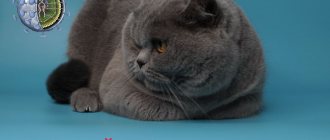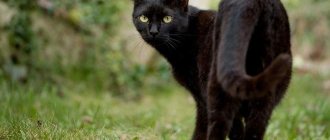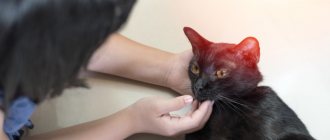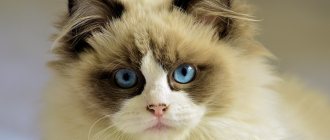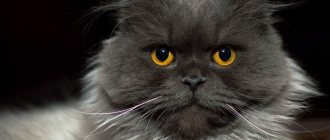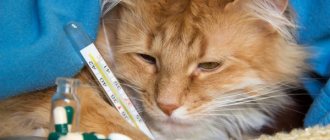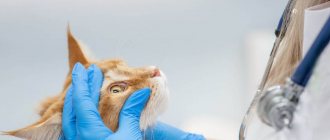Against the backdrop of information frenzy on the topic of Chinese coronavirus transmitted from animals, I would finally like to clarify a little and tell you what coronavirus is in cats and how it manifests itself. Zoo veterinarian Marina Mikheenko will help you figure this out .
This topic is special for me, since I had to deal with the coronavirus and its companions in full.
Reading how people in China go crazy with fear and throw healthy animals into the trash, only one thought comes to my mind - how you have to be afraid for your own life. If they don’t throw cats away, they pack them in plastic and masks so that the poor animal’s eyes bulge from stress. Thanks to the Chinese epidemic, the whole world learned the word coronavirus and got hundreds of horror stories, dragging dogs, cows, cats and even hamsters into it. And now let’s exhale. Coronavirus in cats is a completely different story and symptoms. It is not even transmitted to dogs from cats, let alone to people. And yes, he is not so deadly scary (although he has his unpleasant moments).
Meet Khardyusha. And he had a coronavirus infection for a whole year, with high titers. But the body outgrew and won, although it took effort and money to treat this cat disease.
Photo: Nathan Antonovich
Photo: Nathan Antonovich
Photo: Nathan Antonovich
Once again, I’m not saying that coronavirus in cats is a piece of cake. But in most cases this is not fatal (depending on the type of virus) and is not transmitted to people, even if you kiss a cat on the nose. In snotty and coronavirus.
– Coronavirus is an RNA virus found in all mammals. Has several types. It got its name for its similarity in structure to a crown (corona in Latin), explains veterinarian Marina Mikheenko.
That is, in fact, viruses are generally different, only the structure is the same.
What is coronavirus in cats?
Feline coronavirus infection owes its name to a pathogenic microbe that, under a microscope, looks like a crown, or rather a ball with spike-like protrusions. The mystery is that it constantly mutates. Biologists are still struggling with this problem, trying to understand why a non-pathogenic strain of bacteria suddenly becomes active and transforms into a highly virulent type.
Due to the unknown nature of the disease (strain), effective vaccines have not yet been created.
This is what a coronavirus molecule looks like under a microscope.
The virus includes a protein shell and nucleic acid. The main component of the virus is the genetic RNA chain - the causative agent of the disease. This virus was first recorded by veterinarians in 1966 in America. Presumably, the virus existed before, but was noticed due to increased attention to cats in nurseries.
Feline coronavirus has no geographical boundaries. It can affect not only domestic cats, but also other representatives of the cat family (pallas' cats, leopards, lynxes and others). With strong immunity, the body copes with the infection on its own, manifesting itself as a minor disorder in the gastrointestinal tract. With weakened immune defenses, the mutated coronavirus reliably takes root in the body, causing serious consequences.
If your cat suddenly gets sick, you shouldn’t give up on it. With this disease, the fatal outcome is low (does not exceed 5%). But you cannot hope for a miraculous recovery; you must immediately contact a veterinarian. Otherwise, complications are inevitable. The animal must be quarantined for at least 12 weeks. Upon completion, they are re-checked for infection.
Preventive measures
In the case of coronavirus infection, vaccination does not work. Yes, American scientists have created a vaccine that is actively used in the United States, but its effectiveness is not recognized by European veterinarians.
Thus, the introduction of a vaccine in virus carriers causes an infectious process in the most severe form of its manifestation.
A nonspecific control measure consists of proper care, proper feeding and maintenance in conditions that meet sanitary rules.
In addition, in nurseries it is necessary to do everything possible to prevent the spread of infection among animals, which can be achieved by performing simple measures:
- seropositive animals should not be allowed into the group;
- all newly arriving cats are placed in quarantine, during which (at the beginning and at the end) a blood test is carried out for the presence of antibodies to coronavirus;
- reacting cats are kept in a separate room from healthy cats;
- Wean kittens from mothers who test positive in studies at an early age, thereby ridding the group of the virus.
Until now, humanity has not created a weapon against viruses. These dangerous creatures of nature mutate every year. All living organisms are susceptible to them, from humans to primitive plants. Coronavirus in cats has now begun to change. These younger friends suffer no less than humans from viruses, which often take their lives.
Various variants of the course of the disease
Coronavirus molecules consistently kill healthy blood cells.
Upon penetration into an animal’s body, several options for the development of the disease are possible:
- Asymptomatic . The disease proceeds almost unnoticed, without obvious manifestations and does not pose a threat to the pet. The cat's behavior does not change for the worse and we can say that she is absolutely healthy. However, the carrier of the virus remains, and she is able to infect other individuals through feces. The animal may also suffer from diarrhea throughout its life.
- Light . The virus primarily affects the tonsils and intestines. The pathology develops slowly in a mild form, but over time it becomes chronic. It is often called dry. The body fights it hard and the infection usually subsides. The virus is cleared from the body within a month on average.
- Heavy . It is also called the wet form, which is considered the heaviest in flow. The virus multiplies intensively, leading to the accumulation of fluid in the peritoneum. This occurs due to the leakage of blood from damaged internal organs. Against this background, effusion peritonitis occurs, followed by ascites. If the immune system copes, remission occurs and the wet stage turns into dry. But, in both cases, the death of the animal is inevitable, since the immune cells are completely destroyed.
Mutation scheme
If a cat is a carrier of a dangerous virus, the high risk of developing FIP is only up to a year. Although protective antibodies to coronavirus are practically absent in mature cats, the likelihood of a mild type becoming severe is unlikely.
Types of coronavirus
There are two strains of the virus:
- intestinal (FCoV) - lead to the development of enteritis;
- highly pathogenic (FIPV, FIP) - interpretation of infectious peritonitis virus.
In the first case, the disease is tolerated by the cat relatively easily. Sometimes the owner does not even notice the pet’s ailments. Pathogens affect the mucous membrane of the small intestine, which is accompanied by diarrhea. The second option develops against the background of the first as a result of a mutation of the strain, if the animal is exposed to frequent stress and becomes hypothermic. Peritonitis of infectious origin is often fatal due to the destruction of immune macrophage cells.
Despite the identical origin of these two species, the manifestations are different. For example, a cat infected with intestinal coronavirus will not necessarily develop infectious peritonitis. Even with an acute course of the disease in an animal, there may not be a dangerous virus in its feces.
Is it dangerous for humans?
Feline coronavirus is not transmitted to humans.
People do not have to be afraid of this infection, since the virus is viable only in the body of an animal. Human immunity is resistant to this type of microbe. Even if it gets inside, it immediately dies under the influence of protective antibodies.
Despite this, a person can become a potential carrier of the virus. We are talking about a pet being infected by its owner if the latter fails to comply with basic hygiene rules.
Transmission of the pathogen occurs through contaminated hands, rarely washed everyday objects, food (drink) plates, etc. Therefore, maintaining cleanliness is a prerequisite for keeping a mustache.
Causes of the disease
The sources of transmission of the virus are usually the cats themselves, who are sick or have already been sick and become carriers of the pathogenic virus.
Causes of defeat:
- contact with waste products left by an infected cat (licking individual parts of the body after relieving itself in an infected tray);
- nasal discharge from a virus carrier that does not stop for several months after the illness;
- eating food that a sick cat eats (if you have access to its bowl).
In rare cases, you can become infected through airborne droplets when you are near a sneezing infected animal. Coronavirus, when released into the external environment, is still infectious for a short period. However, in dry air the pathogenicity instantly disappears.
Coronavirus transmission animation
Coronavirus dies from low humidity, under the direct influence of ultraviolet radiation and disinfectants. The latter refers to the disinfection of coronavirus in cats - the owner must clean the tray daily and treat it with antibacterial drugs.
This rule applies not only to those owners who have several pets. Even one animal can infect itself several times. But even after contracting coronavirus, a cat does not necessarily become a virus carrier. Some individuals, after recovery, do not release pathogenic particles into the environment.
But stray cats absolutely carry the virus within themselves and are capable of spreading it wherever they leave their feces. And owners of mustachioed pets can bring the virus from the street into the house with their shoes. Therefore, even a completely domesticated cat is not protected from such a disease .
Spread of the virus
Symptoms of the disease
It is difficult to accurately describe the symptoms of coronavirus infection due to its ability to manifest itself differently due to mutation. Even veterinarians often make mistakes in this regard and can make an incorrect diagnosis.
An infected cat may appear healthy in appearance
Let's consider all the possible signs of this disease, regardless of type and form:
- sudden loss of appetite;
- vomit;
- lethargy and drowsiness;
- long-lasting loose stools not related to nutrition;
- bloody or mucous discharge in stool;
- fever interspersed with chills, which is caused by fluctuations in body temperature;
- impaired coordination in movements;
- restlessness, fear of light;
- the appearance of blood vessels in the eye;
- damage to the central nervous system;
- redness of the oral mucosa;
- abdominal enlargement (indicates the development of peritonitis).
In an infected cat, the biochemical blood test is normal, and the general blood test shows an increase in the level of ESR and lymphocytes. This indicates cellular immunodeficiency.
Symptoms can occur together or separately. But even if there are several from the list, you urgently need to undergo the appropriate tests. The earlier the diagnosis is made, the easier the treatment will be.
Signs of infectious peritonitis
Complicated forms of coronavirus in an animal can be assumed based on the following signs:
- persistent vomiting;
- diarrhea with blood clots;
- elevated temperature;
- the desire to hide in a dark place;
- apathy towards everything, including food;
- yellowing of mucous membranes, ears;
- pale gums;
- cough;
- bloating of the abdominal cavity.
At the initial stage of the disease, the first disturbances are observed in the gastrointestinal tract , then the kidneys and liver fail. In the final stages, the central nervous system is affected, which is accompanied by convulsions and paresis in the animal.
Viral peritonitis (FIP) of cats. Veterinarian advice
Signs of enteritis
Coronavirus gastroenteritis manifests itself in cats as follows:
- inactivity and refusal to eat;
- intestinal disorders;
- changes in body temperature;
- strong thirst;
- mucus from the nose;
- lacrimation.
The clinical picture is so unclear that viral enteritis is often mistaken for food poisoning.
Elimination of symptoms is the main stage of treatment
Further therapy depends directly on the manifestations of coronavirus enteritis or peritonitis. If the infection provokes an increase in body temperature or surges in blood pressure, appropriate medications must be prescribed. In addition to traditional antipyretic and anti-inflammatory drugs, veterinarians can prescribe intramuscular administration of antispasmodics, for example, no-shpa. Treatment usually continues until symptoms are completely eliminated.
In case of significant dehydration and weight loss, the task of doctors is to provide additional nutrition to the body. Cats are prescribed droppers with a solution of sodium chloride and glucose, and additional vitamin complexes.
The symptomatic treatment described above, care and appropriate care for your beloved cat will give him a good chance of recovery. With infectious peritonitis, as a rule, the prognosis for animals is disappointing, but the onset of death can be delayed for some time. To do this, it is necessary to periodically pump out the accumulated fluid from the cat’s abdominal cavity.
Tests and diagnostics for coronavirus
If your cat is infected with coronavirus, it is important to start treatment as early as possible. And for this, it is better to play it safe and get tested, even if your pet has no visible signs of illness. After all, virus carriage can persist without clinical manifestations. This way you can protect other pets living in the house.
There is no specific test for detecting KVK infection. Diagnostics includes several stages:
- ICA/ELISA of blood or plasma . Determines the concentration of antibodies to the virus. A reduced level indicates weak immunity, when the animal’s body is not able to adequately repel pathogenic attacks, but this does not mean the absence of infection. If the virus is present, the test is positive, but where it is localized (in the tissues or intestines) is unknown.
- PCR/ICA of feces . Allows you to detect the virus in cat feces. A positive reaction indicates that the animal is infected, which requires its complete isolation from the rest - healthy ones. If the test is negative, the cat may be a carrier of the virus without releasing it into the external environment.
- Donating blood for PCR to detect coronavirus in cats . This is one of the most inaccurate methods, often showing erroneous indicators.
- Antibody titer . Makes it possible to determine the amount of antibodies in the blood serum, which shows the degree of damage. Based on the established values, the doctor can prescribe the correct treatment regimen and give an accurate prognosis of the development of events.
The simplest methods for laboratory diagnosis of infectious peritonitis are biopsy and histological examination of tissue. Only these are complex and expensive procedures that are not carried out in every veterinary clinic. It happens that to establish an accurate diagnosis you have to resort to a number of analyzes and tests.
It is possible to establish feline coronavirus only after passing more than one test
What to do if the test is positive
If the analysis shows a positive reaction, additional testing is required. It includes:
- blood biochemistry;
- titer test for the content of protein fractions in the blood;
- repeat serological analysis.
If infection with peritonitis is confirmed, the animal is prescribed a puncture from the peritoneum. This is done to examine the accumulated liquid.
This is what a test with a positive result looks like
The owner himself does not need to panic in such a situation. It is not a fact that the infection will develop into a complicated form that cannot be treated (FIP). What to do first:
- If possible, remove healthy pets from sick ones. If this does not work out, each animal has its own tray, bowl, and scoop. Toilets should be as far away from the feeding area as possible.
- Clean the trays daily and treat them with disinfectants (for example, bleach). It’s better not to add filler at all. After washing the bowls, pour boiling water over them. Change drinking water twice a day.
- Change the textiles in the room to ones that can easily be washed frequently. It is advisable to remove carpets as it will be difficult to clean them regularly. In this case, a vacuum cleaner is not the best solution, since the air flow will spread the infection.
- Install ionizing air purifiers in the room. If possible, periodically turn on UV lamps, which are good at killing germs.
- Spray a herbal infusion of chamomile and oak bark into the animal's mouth once a day. In addition to its disinfecting effect, it strengthens the mucous membrane.
- Cancel all planned events: mating, visiting exhibitions, etc.
- Transfer your pet to a special diet. Eliminate everything fatty.
- Try to exclude any acute experiences in the animal. So, for the next 2 months you cannot carry out castration (sterilization) or anything else that can cause stress.
Unfortunately, with coronavirus there is no talk of a complete recovery. When this infection is detected in an animal, the veterinarian prescribes symptomatic treatment for the animal, which allows it to locally combat pathologies that manifest themselves externally (liver dysfunction, prolonged diarrhea, ascites as a result of fluid accumulation in the abdomen). Therapy is aimed at stabilizing the pet’s general condition.
PCR tests (Polymerase chain reaction)
Forms of the virus
The course of the disease directly depends on the bacteria that has entered the body of the individual. They build on it when prescribing medications and therapy. There are three options for the development of malaise:
- asymptomatic;
- easy;
- heavy.
First option
considered the most common. This strain poses a threat not to the carrier, but to domestic relatives living in the neighborhood.
Mild course
typical for adults. Infection with bacteria provokes the development of enteritis. Diarrhea, high fever, runny nose, eye inflammation, and vomiting accompany the disease. The animal experiences pain in the abdomen, and a white coating forms on the tongue. Coronavirus enteritis in cats combines symptoms of poisoning and colds.
Severe leakage
associated with a sharp deterioration in condition, loss of appetite, and vomiting. Weight loss begins, mucous membranes begin to turn pale. With the wet subtype, ascites develops - accumulation of fluid in the abdomen, dysfunction of the kidneys, liver, and vascular damage. Muscle tissue gradually loses elasticity, and cramps are possible due to disturbances in the functioning of the nervous system.
The dry subtype is characterized by a sharp decrease in weight, and in later stages – a problem with the functioning of internal organs. The infection often combines both types or one begins to mutate into the other.
Wet inflammation without proper treatment lasts for about six months, then becomes dry, causing the death of the pet. Dry peritonitis is considered chronic, slowly and over a long period of time destroying the cat’s body.
Treatment
There is no single treatment plan yet, including the antiviral drug. Carrying out therapy only with antibiotics will not give the desired results. They are included if a bacterial infection is added to a viral one. In general, coronavirus therapy is aimed at getting rid of external symptoms, stabilizing the immune system and improving the condition of the mustachioed patient.
The clinic through the eyes of a veterinarian! It is not practical to treat coronavirus in its chronic form. Drug therapy will only worsen the cat’s condition, or more precisely, it will completely damage the liver. While the virus remains in the body. Medical intervention will come in handy when the virus has mutated into FIP or progressed to gastroenteritis.
General therapy
When a coronavirus infection is detected in a cat, the two most effective drugs are usually prescribed: Roncoleukin and Polyferrin-A. If fluid accumulates in the sternum and abdominal area, it is pumped out using a puncture.
Some owners in such a situation limit their pet's drinking. This absolutely cannot be done. The animal can consume as much water as required. Excess fluid can be removed with diuretics (diuretics). In case of vomiting and diarrhea, sorbents (for example, activated carbon) and antiemetic medications are prescribed. And in order to avoid dehydration, the animal’s body is supported by drips with special compounds: blood substitutes, saline solutions and other means as prescribed by the veterinarian.
Saline solutions with glucose are prescribed to maintain the strength of a sick animal
Vitamin supplementation is required throughout the entire treatment. To do this, purchase special complexes from a veterinary pharmacy. Usually these are B vitamins and ascorbic acid. In addition, veterinarians recommend taking immunocorrectors (for example, immunoglobulin) in parallel.
As soon as the cat stops vomiting and diarrhea, feeding is restored in a special mode. After all, to counter the virus you need strength. The priority should be high-calorie food, but dietary:
- Chicken broth.
- Rice or oatmeal porridge.
- Fermented milk products.
Remove fatty foods from the diet. If the pet is on industrial food, then this partially eliminates many problems. As a rule, ready-made mixtures have a balanced and satisfying composition.
At the reception
Enteritis therapy
The mild form of coronavirus is more difficult to diagnose, but easier to treat. After the virus is detected, the animal is limited in food. The first day they give only clean water. In case of dehydration, a drip with vitamins and glucose is placed. For severe diarrhea, strengthening medications are prescribed.
On the second day, the infected patient is switched to oatmeal cooked without adding milk. From the fourth day, low-fat minced meat is gradually introduced into the diet. If all this time the animal has a stable high temperature and signs of gastrointestinal distress do not disappear, antibacterial therapy is introduced.
The treatment course ends with vitamin supplements, probiotics and prebiotics, designed to restore the intestinal microflora.
Treatment of peritonitis
Peritonitis is much more difficult to treat, although this form is rare in cats. Veterinarians have developed a unified scheme:
- Relieving pain . To do this, apply a cold compress to the stomach and give painkillers.
- Symptomatic therapy . The doctor prescribes the same medications as for gastroenteritis. To facilitate breathing, the animal undergoes a puncture of the abdomen to remove the accumulated fluid. True, such a measure is temporary.
- Stabilization of the gastrointestinal tract and boosting immunity . Colon cleansing is performed using enteral lavage with saline solution. The immune system is strengthened by taking vitamin and mineral complexes.
Antibacterial drugs
List of antibacterial agents for coronavirus therapy:
- Tylosin;
- Amoxiclav;
- Levomycetin;
- Penicillin.
Prev
Next
Diuretics for coronavirus
List of commonly prescribed diuretics:
- Kotervin;
- Lasix-Neo;
- Urotropin;
- Indapamide;
- Furosemide.
Prev
Next
Immunomodulators
Means for correcting immunity:
- Immunoglobulin;
- Maxidin;
- Fosprenil;
- Gamavit.
Prev
Next
To strengthen the immune system, you can use folk remedies - infusion of nettle and rosehip.
Immunostimulants are recommended in the form of cat vaccinations. Then the effect will be better. In addition, when taken orally, the intestinal mucosa does not accept the medicine well.
Probiotics
Antibacterial intervention during treatment not only destroys the pathogenic environment, but also negatively affects the beneficial intestinal microflora of the animal. Therefore, upon completion of treatment it is required to restore it. Probiotics are used for this:
- Fortiflora;
- Zoonorm;
- Subtilis;
- Enterol and others.
The duration of the appointment is determined by the doctor.
Specialist additions! Typically, probiotics are prescribed to be taken in parallel with an antibacterial course. Sometimes they are canceled, but lactobacilli are prescribed instead. This is due to the fact that the intestinal microflora suffers the most. Just don’t self-medicate in this regard and overdo it with probiotics. This can lead to addiction, which can lead to more serious problems.
Prev
Next
Possible complications
Feline coronavirus is dangerous because it can transform into FIP at any time. The main factor provoking the development of this incurable disease is natural origin. So, cats of the following breeds are more susceptible to this:
- Abyssinians;
- British Shorthair;
- Australian smoky;
- Bengals;
- Burmese;
- rexes;
- Scottish folds.
The most risky age for the clinical manifestation of FIP is before one year and after 10 years . Severe stress in an animal can stimulate the development of the disease.
Do kittens get sick and how are they treated?
Kittens also suffer from coronavirus.
Coronavirus infection is not very selective in terms of choosing the target of infection. Any animal, regardless of breed and age, can get it. Scientists are still puzzled as to why some organisms are more resilient. But based on veterinary practice, the most vulnerable groups of cats can be identified: albinos, elderly males and kittens.
Despite the inability to become infected in the womb, a month after birth a cat can become infected with coronavirus. Typically, symptoms clearly manifest themselves when the baby is separated from the mother cat. Kittens up to one and a half years old have a weakened immune system, so in the event of a viral infection, the body is unable to resist the pathogen. Immune protection stabilizes in cats by the age of two.
If a kitten is infected, treatment will be the same as for an adult cat. The only thing is that age restrictions are taken into account when taking a number of drugs. Therefore, it is not recommended to give any medications on your own.
Vaccination
Vaccinations are considered the most effective prevention of coronavirus infection. The vaccine is administered to the kitten during the first 14 days from birth. But vaccination should not be considered 100% protection against coronavirus. It reduces the likelihood of the disease, but does not eliminate it completely, since such vaccines have not been developed to date.
Coronavirus infection is one of the most common diseases in cats, which can occur without pronounced symptoms.
The disease poses a serious threat to the pet’s health, so it is very important to contact a veterinarian immediately after the first signs of coronavirus or changes in the cat’s behavior
Coronavirus vaccines
Scientists are still trying to develop an effective, and most importantly, safe vaccine. Currently, the intranasal vaccine from Pfizer, Primucell, is actively used. It is created on the basis of a temperature-dependent strain of coronavirus (reproduces exclusively at low temperatures in the oral cavity). Thanks to this, local protection is developed at the site where the pathogen enters the body, but a sufficient amount of antibodies is not synthesized.
Vaccination with this drug is relevant against FCoV. But in the case of infectious peritonitis, the effectiveness of the vaccination is not guaranteed. Although, when infected with the virus, the animal will experience a milder form of the disease.
Veterinarians advise vaccinating cats before they reach 16-17 weeks. But often babies have already become infected by this point. To get vaccinated, a doctor is called to your home to avoid contact of the infected pet with healthy people. After the procedure, you cannot let the cat go outside or attend exhibition shows for at least 3-4 days.
Vaccine for prevention
Animals staying in nurseries are at greatest risk - there the virus can be more actively transmitted due to overcrowding. Therefore, before taking a baby from there, you need to find out from the breeder about cases of coronavirus disease in this community.
Preventive measures
In the case of coronavirus infection, vaccination does not work. Yes, American scientists have created a vaccine that is actively used in the United States, but its effectiveness is not recognized by European veterinarians. Thus, the introduction of a vaccine in virus carriers causes an infectious process in the most severe form of its manifestation.
A nonspecific control measure consists of proper care, proper feeding and maintenance in conditions that meet sanitary rules.
In addition, in nurseries it is necessary to do everything possible to prevent the spread of infection among animals, which can be achieved by performing simple measures:
- seropositive animals should not be allowed into the group;
- all newly arriving cats are placed in quarantine, during which (at the beginning and at the end) a blood test is carried out for the presence of antibodies to coronavirus;
- reacting cats are kept in a separate room from healthy cats;
- Wean kittens from mothers who test positive in studies at an early age, thereby ridding the group of the virus.
Disease prevention
Coronavirus infection is one of the most common serious diseases among domestic cats; dogs tolerate it much more easily. Scientists even compare this disease with blood leukemia (leukemia). Therefore, it is easier to prevent damage than to look for treatment methods later.
Veterinarians recommend following basic measures:
- Create decent living conditions for your pet . The room should be dry, clean, and warm. The animal's resting bed, food and drinking bowls, litter tray, and other household items are regularly washed and disinfected. It should be noted that the pathogenic microbe dies at high temperatures, under the influence of ammonia and sodium hypochlorite.
- Organize a balanced and nutritious diet . Be sure to include vitamin and mineral supplements in the diet if the cat is on natural food (ready-made food already contains them).
- Strengthen the animal's immunity in every possible way . To do this, they periodically visit a veterinary clinic for examination and obtain medical prescriptions. Take your pet out into the fresh air more often. You can plant a special herb on the windowsill, which is useful not only for the immune status, but also for health in general. Any diseases are treated without delay to avoid complications.
- Before adoption, the kitten is placed in a two-week quarantine (isolated) . This is provided that there are other pets in the house. It is also unacceptable for a domestic cat to come into contact with stray animals while walking.
- Follow a deworming schedule and treat for fleas . It is advisable to carry out antihelminthic treatment once every 3 months. These parasites greatly weaken your pet's immune system, thereby putting it at risk of contracting the coronavirus.
The owner should try to avoid frequent stressful situations for his pet. This means: moving to another place, transferring the animal into other hands, traveling together, etc. This has a detrimental effect on the immune system.
To be on the safe side, it is recommended to get a vaccine, but it does not provide a 100% guarantee of safety against coronavirus infection. Breeding cats and female cats should be tested for the virus twice a year. Tests are required before each mating. Seronegative and seropositive individuals cannot be mated, otherwise infection is inevitable.
How can an animal become infected?
global $ads_google; //data-ad-slot=”2475549904″ $ads_google = empty($ads_google) ? false : true; ?> if ($ads_google == false) {?>
$ads_google = true; ?> } ?>
The infection is contagious, therefore, among all sources of infection, the virus-carrying animal takes first place. It doesn't matter whether he shows symptoms or not. In this regard, any accumulation of cats on the street, nurseries, shelters, and even accidental contact with a sick individual pose a danger.
Indirect communication through shared care items also plays a role. The source of the coronavirus can be food and water bowls, a tray, and beds. They contain saliva or traces of excrement through which the microbe is transmitted. After a sick cat, the virus lives on objects for another 24 hours, after which it is destroyed. Eating the feces of relatives on the street is also a risk factor for cats, since the coronavirus remains viable in them for much longer - up to several months.
Popular questions and answers
Conscientious and caring owners are always concerned about the condition of their pet. This is especially true for possible diseases. But the coronavirus is a separate topic, about which many questions arise. The main ones are answered by specialists.
Is coronavirus transmitted from cats to dogs?
Cats cannot transmit coronavirus to dogs, and vice versa, due to their different physiologies. It is worth noting that a dog vaccine will be useless for cats if they are infected with the virus. In scientific terms, the virus has different genesis.
Here, for comparison, we can cite a human virus from China. They have the same name, but it affects a single living organism differently. The same goes for human and feline AIDS.
Statements from a veterinarian! Dogs also have their own coronavirus, similar to that of cats. It manifests itself in the form of symptoms, as in gastroenterocolitis and respiratory lesions. However, the virus does not mutate into a complicated form of FIP.
Can it be treated at home?
As such, the measures that an owner can take against coronavirus infection in an affected pet can hardly be called a full-fledged treatment. The main thing is to protect the animal from nervous overexcitation, which greatly weakens the immune system and aggravates the situation.
Therefore, it is necessary to provide the cat with comfortable living conditions and strengthen the body’s protective properties with the help of vitamins and minerals in the form of special supplements. If there are gastrointestinal disorders and concomitant infections in an animal, try to cure them as quickly as possible. Here you need to focus on test results and doctor’s orders.
Veterinarians say that it is not the virus itself that should be feared, but its mutation. In most cases, this is what leads to the inevitable death of the cat. A person does not have the opportunity to somehow prevent or influence the process of mutation of a microbe. This phenomenon depends on the immune status of the animal and the severity of the lesion.
Kittens aged six months to one year are resistant to coronavirus. From a large litter, usually only one baby can get coronavirus peritonitis. It is easy to become infected directly with coronavirus, but peritonitis is almost impossible (it is not contagious). Only the intestinal form of infection – gastroenteritis – can be transmitted.
Is coronavirus transmitted from cats to humans?
Veterinarians have noted this trend today - there have been many requests to euthanize their mustachioed pets due to their coronavirus infection. Many compare it to Covid-19 and are afraid of getting infected. Only these are completely different diseases.
Feline coronavirus is a certain strain of pathogenic bacteria, similar in type to the causative agent of human herpes. Only the herpes virus is present in almost everyone. The situation is similar with the cat - it is in the natural nature of the physiology of cats. Under severe stress or having been ill with something, the cat’s immunity is weakened. Against this background, the virus mutates and it dies. But most animals live quietly with this pathogen, which is in a “dormant state.” And they are not dangerous to people.
Even by kissing your pet, infection will not occur. Only with constant contact with an infected cat (if it is a stranger) can you bring the pathogen into your own home and infect your cat. Therefore, if your pet is diagnosed with coronavirus, you should not immediately abandon it.
How is coronavirus transmitted in cats?
Cats usually become infected with coronavirus enteritis through their own feces. It is rare that the virus is transmitted through saliva or airborne droplets. And the FIPV form is generally viable only in blood cells, and therefore is not excreted through feces and saliva.
It is impossible to become infected with infectious peritonitis that develops against the background of coronavirus. It is a consequence of gastroenteritis - a mutation of the pathogenic strain.
Do cats get sick with covid 19 coronavirus?
Antibodies to different types of coronavirus are present in most cats and dogs. But all forms are in no way related to the human disease called Covid-19. So cats don't get sick from it.
Can a cat get coronavirus from a person?
Those sick with the Covid-19 coronavirus are advised not to have close contact with pets, as there is a possibility of transmitting the virus. Although in reality only one such case was recorded. This happened in Belgium, where the owner infected his cat.
Therefore, you should entrust the care of your pet to someone close to you. If this is not possible, then wear a protective mask and follow basic hygiene rules (wash your hands often, do not kiss an animal or allow yourself to be licked by it, do not give food from your hands).
Coronavirus infections in cats
T.V. MASLENNIKOVA, practicing veterinarianCats are susceptible to infection by several types of coronaviruses: depending on the type of pathogen, clinical signs vary from asymptomatic and moderate enteritis to widespread fibrinous serositis and vasculitis, known as feline infectious peritonitis. Classic exudative (wet) feline infectious peritonitis (FIP) is characterized by the exudation of sticky, straw-colored fluid into the peritoneal and pleural cavities. Non-exudative (dry) FIP is characterized by the manifestation of chronic granulomatosis of organs and systems. Both forms, unfortunately, are fatal.
The first publications regarding FIP were made in 1963 by Holzworth, but it was almost 20 years later that the virus causing FIP was isolated (Horzinek & Osterhaus, 1977). Moderate enteritis associated with coronavirus infection was first described in 1981 (Pedersen et al., 1981), although previous serological surveys showed the presence of antibodies in 20% of domestic and 95% of wild cats (Pedersen, 1976; Osterhaus et al. ., 1977).
In addition to the strains of feline coronaviruses that cause FIP (FIP=FIPV) and enteritis (feline coronavirus enteritis FECV), some strains of canine coronaviruses are capable of infecting cats, which has been proven experimentally.
etiology
Coronaviruses belong to a family of pleomorphic RNA viruses, approximately 100 nm in diameter and surrounded by a characteristic corona.
Coronaviruses are relatively labile feline viruses that die within 1-2 days at room temperature. They are easily inactivated by heat and most disinfectants and detergents, but are relatively resistant to phenols, low temperature and low pH. For example, the FIP virus remains stable in organ homogenate for many months at a temperature of -70 C, resisting repeated freezing and thawing.
The classification of coronaviruses that infect cats is very confusing and will probably only be deciphered by studying their molecular structure. FIP and FECV were initially considered to be separate variants, but are now often viewed as extremes of the spectrum of feline coronaviruses based on infectivity and pathogenicity.
Indeed, FIP virus strains have been suggested to be mutants of FECV. Of course, they are very closely related and difficult to differentiate in the laboratory. However, some researchers have found differences between these viruses using monoclonal antibodies.
FIPV and FECV are members of a large group of coronaviruses that also includes porcine transmissible gastroenteritis virus (TGEV) and canine coronavirus (CCV), as well as human respiratory tract coronaviruses 229E. Some differences in the antigenic structure and genomes of TGEV and FIPV were discovered in laboratory studies, while FIPV and CCV, on the contrary, turned out to be very similar in structure.
pathogenesis
The clinical manifestation of coronavirus infection in cats depends on several factors, including the strain and dose of the virus, age, immune status and other innate characteristics of the cat. In particular, the strain of the virus and the body's ability to mount a cellular immune response are important indicators in determining the pathogenesis of the disease. The role of antibodies in the course of feline infectious peritonitis is very complex, since the spread of immunoglobulins can cause clinical manifestations and the further course of the disease. The usual route of infection is oral, although some researchers point to the importance of inhalation and respiratory infection.
Transplacental transmission of the virus is also possible. After oral infection with FIPV, FECV, CCV, the virus can be isolated from the saliva and feces of experimentally infected animals. The portal of infection of the virus is the tonsils and small intestine, although the virus can also be found in the mesenteric lymph nodes, such transfer is carried out by macrophages. Intestinal infection sometimes occurs in the form of mild or more severe diarrhea, although it is usually asymptomatic.
According to the scheme, which describes the possible course of events during a coronavirus infection, if the virus is of low pathogenicity or if the animal's body exhibits a strong immune response, then the virus is eliminated (or at least its spread is controlled) and no further clinical symptoms are observed. This occurs when infected with FECV or most strains of CCV.
After infection with more pathogenic FIP-stimulating strains of the virus and in the absence of a pronounced cellular response, viremia develops and the virus spreads to various organs and tissues. Macrophages play an important role in the spread of the virus. The type of viral infectious peritonitis depends on the level of the cat's cellular immune response. Individuals with a weak cellular immune response develop acute wet infectious peritonitis, and those with a moderate immune response develop the chronic granulomatous form of dry FIP. The manifestation of clinical symptoms of the wet form begins three weeks from the moment of infection. The dry form requires a longer time.
The role of antibodies in the pathogenesis of infectious peritonitis is complex. Although infected animals produce large amounts of antibodies that can neutralize the virus, the proliferation of immunoglobulins can cause accelerated development of wet FIP in cats. The mechanism for this enhancement is unknown, although it has been suggested that it may be due to opsonization of the virus bound by the antibody, thereby enhancing the uptake of the virus by macrophages. Alternatively, this process may proceed through the creation of an immune complex depot and activation of the endothelium of the vascular wall.
The phenomenon of increasing antibody titres obviously needs to be taken into account during vaccination, but their role in the pathogenesis of most cases of FIP is still unknown.
Clinical signs
There are several clinical signs associated with feline coronavirus infection, but in most cases no symptoms are observed. Enteritis due to low virulence coronavirus infection (for example, FECV) - moderate and short duration. This usually happens in kittens, especially after weaning. Diarrhea develops after 2-7 days. after experimental infection. Sometimes diarrhea is preceded by transient vomiting. FIP is more severe when associated with a bacterial infection, but reports of fatal hemorrhagic diarrhea are rare.
Initial symptoms in wet and dry forms are nonspecific and may be missed during examination and observation. Common symptoms of both forms of infectious peritonitis include: anorexia, depression, lethargy, fluctuating antibiotic-independent fever, weight loss, nonspecific gastroenteritis, anemia, shortness of breath, jaundice.
The wet (exudative) type causes an immune complex that damages small blood vessels, thereby causing leakage of protein in the form of effusion into closed natural body cavities. With this form of FIP, the development of the disease progresses, and the expansion of the abdominal cavity increases due to the accumulation of ascites fluid. In 25% of cats with this form, there is a simultaneous accumulation of effusion in the pleural cavity.
In the non-exudative (dry) form, granulomatous lesions develop in a number of organs and clinical symptoms depend on the damage to a particular organ. The most severely damaged organs are the abdominal organs (especially the liver, kidneys), the central nervous system and the eyes.
Consequently, the most prominent clinical signs are weight loss, depression, and episodic hyperthermia. CNS lesions can lead to a range of neurological symptoms, including ataxia, paralysis, paresis, incoordination, nystagmus, seizures, and peripheral nerve palsies.
When the eyes are affected, iridocyclitis, retinitis, and uveitis of varying severity develop, which may be the only clinical manifestation of the disease.
Although the two forms of the disease are described as different, they are not mutually exclusive. Lesions of the eyes and central nervous system can be detected in 10% of cases with the wet form, and many cats have lesions characteristic of the dry form, but this is discovered, unfortunately, only at autopsy. There are also descriptions of cases of wet FIP during the recovery phase, but then the dry form of the disease develops.
diagnosis
Making a diagnosis (especially in the dry form) is significantly difficult and must be based on clinical signs and laboratory results. For a final diagnosis, it is necessary to perform a tissue biopsy and microscopic examination.
Due to the nonspecific nature of the clinical symptoms associated, in particular, with the dry form of the disease, FIP is accompanied by weight loss, loss of appetite and hyperthermia. Other diseases that should be considered in such cases include FELV, FIV infections, and toxoplasmosis.
Very careful examination of the eyes should be carried out on suspected animals, as the eyes alone may have a single, easily detectable lesion. When pleural effusion occurs or ascites forms, infectious peritonitis is one of the main differential diagnoses.
In the USA, for example, radiography of the abdominal cavity was performed to make a diagnosis, and the “ground glass” phenomenon manifested itself when the abdominal cavity was filled with fluid; the serous surfaces were scattered and recognition of specific organs was impossible. Even after centesis of the fluid, it is difficult to distinguish the lines and outlines of organs in the abdominal cavity. Diagnosis is not based on radiography, but these data can be used in differential diagnosis. FIP should also be considered for neurological symptoms when the cause of the latter is not identified.
The wet form must be differentiated from other causes of ascites and/or pleural effusion such as lymphocytic cholangitis, tumors, pyothorax, bacterial peritonitis, heart disease and cirrhosis of the liver. Removal of fluid from the cavity and analysis of it can distinguish FIP from other diseases, although cats with lymphocytic cholangitis may have ascites fluid with similar biochemical properties. When wet, the liquid is often yellow or gray and very sticky and viscous, it has a high concentration of protein, largely containing gamma globulins, and foams easily when shaken. If the liquid is left to settle, a clot will form. Microscopic examination of the fluid shows the presence of neutrophils, lymphocytes, macrophages and mesothelial cells. In representatives of the cat family, along with damage to the eyes and central nervous system, there is also an increase in serum protein in effusions; cells are found in all body fluids, including in the cerebrospinal fluid.
Hematological changes in both wet and dry forms are similar. Leukocytosis with neutrophilia, lymphopenia, and moderate non-regenerative anemia are observed. Infection combined with FeLV causes deeper anemia and is often accompanied by panleukopenia.
Serum protein level is one of the most important standard biochemical tests for FIP. In both wet and dry forms, hyperproteinemia with an increased content of gammaglobulin is observed due to the formation of a large number of antibodies to coronavirus. In the early stages of the disease, blood clotting time decreases significantly, but increases as the disease progresses. Other biochemical parameters, such as liver enzymes, bilirubin, and urine, may be altered due to the development of granulomatous lesions in relevant organs.
Isolation of coronavirus during clinical course is usually impossible; if this was possible, then one of the difficulties was in cultivating strains of this pathogen.
In the future, methods for detecting immune complexes such as ELISA, IFA, PCR, ELISA (KELA), as well as biological tests such as the viral neutralization reaction, will be widely used in veterinary practice, but for now such tests are used as indicators of coronavirus infection. The main drawback of the proposed tests is the difficulty in identifying FIP-stimulating and small intestinal strains, as well as after convalescence and ongoing infection. High titers are more indicative of a general infection and, if accompanied by clinical symptoms, are often considered diagnostic of FIP. Lower titers are usually interpreted as a sign of small intestinal infection. However, the serum of some cats with acute exudative peritonitis may contain no antibodies at all. Conversely, high antibody titers can be detected in cats without clinical symptoms, possibly during convalescence. This once again demonstrates the difficulty of interpreting serological tests for FIP and the impossibility of using them as the only ones to confirm the diagnosis. Therefore, euthanasia should not be performed based solely on these tests.
A definitive diagnosis of FIP is only possible through histological examination of biopsy or postmortem material.
pathological changes
A characteristic feature when opening the abdominal cavity of a cat with an exudative form of infectious peritonitis is the presence of a large amount of ascites fluid, in a volume of several hundred milliliters. Ascitic fluid is straw-yellow or gray and may be clear or contain fibrin strands. Pleural effusions have a similar appearance. Many serous surfaces are covered with a grayish-white fibrinous coating, and the omentum is often opaque, thickened and granular. Granulomatous lesions within organs appear as white lesions on the cut surface. In the chest cavity, pleural lesions often extend to the lungs. Ascites in the non-exudative form of FIP rarely has fibrinous exudate, but granulomas of various sizes are often found, although many of them (in the dry form) are small and similar to those found in cats with the wet form, in some organs (especially: liver, kidneys). , lymph nodes) damage can reach several centimeters in diameter. Macroscopic changes in the central nervous system are rare. Macroscopic changes in the eyes have already been described previously.
histopathology
In wet FIP, there is a fibrinous coating on the serosal surfaces of most internal organs. The omentum and serosa contain numerous small pyogranulomas, some of which are visible to the naked eye, and areas of mesothelial hyperplasia, especially on the spleen. Granulomas typically consist of a necrotic core and neutrophils surrounded by lymphocytes, plasma cells, and many active macrophages.
Granulomatous infiltrates in the liver may involve the bile ducts (vasculitis of the gallbladder wall).
In the lymphoid organs of the abdominal cavity, follicular hyperplasia was noted, pyogranulomatous foci were noted both in the mesenteric lymph nodes and in the spleen.
Histopathological changes in the central nervous system manifest themselves in the form of phlebitis of the meninges and choroidal membranes, but in the absence of thrombosis.
Fibrinocellular exudate found inside the eye makes the intraocular fluid appear cloudy. Excess melanin can accumulate in the choroid of the eye.
Injuries to skeletal muscle, testes, peripheral nerves, and bladder are rare.
treatment
Unfortunately, there are no etiotropic drugs for the treatment of FIP. If signs of wet or dry FIP appear, the prognosis is poor. Removing the fluid provides only temporary relief because new ascites fluid accumulates very quickly. Combination therapy using prednisolone and cyclophosphamide can cause long-term remission. However, this improvement is only temporary and longer use of corticosteroids may worsen the condition due to suppression of cellular immunity. Broad-spectrum antibiotics should also be used.
Some immunomodulators, recombinant DNA containing human interferon alpha and feline fibroblastic interferon beta, have shown good antiviral effects against coronaviruses in vitro, but they were ineffective when studied in cats.
In the early stages, ribaviran (Virazole), adenine arabinoside (Vidarabine) also showed effectiveness against coronavirus infections, however, the toxic effect of ribaviran manifests itself in therapeutic doses.
AZT (Retrovir) and acyclovir (Zovirax) are not effective.
Amphotericin B and macrolides used to treat systemic mycoses have shown good results in vitro. However, the nephrotoxic effect of amphotericin B seriously reduces the possibility of its use in this disease.
Some success has been achieved with the immunomodulator promodulin. Very rarely, some cats recover from FIP, although the role of treatment used is usually unclear. It is likely that symptomatic treatment and special care are most effective in the early stages of the disease.
In the United States, subconjunctival injections of triamcinolone acetonide are used to treat FIP in lesions limited to the eyes.
The greatest success can only be achieved using combination therapy. For example, the use of an antiviral agent to suppress viral growth and an immunomodulator to enhance immune status (a combination of ribavirin and alpha interferon) gives a good synergistic effect against coronaviruses in vitro.
Unfortunately, effective treatment is only in the development stage.
prevention and control
There are reports of coronavirus infection in domestic cats all over the world; as for other wild felines, coronavirus infection has only been described in animals kept in zoos. Serological surveys of cats suggest that 20% of domestic cats and 95% of wild cats have the infection. Such examinations cannot, of course, differentiate between FIP stimulating strains, FECV or CCV.
Clinically, FIP occurs in cats of any age, although animals under 2 years of age and over 11 years of age are most often affected. In England, FIP occurs in pedigree cats such as Burmese and Persian cats.
Most cats are likely to become infected from the mother or other adults or kittens during the first weeks of life, although horizontal transmission among susceptible adults can also occur.
Some canine coronaviruses can infect cats, although their role in the epidemiology of the disease is not yet known.
Feline (and canine) coronaviruses have been experimentally shed in the feces and saliva of cats for several days to weeks before the onset of clinical disease. It is likely that infected animals are a source of infection for other individuals of this species before the onset of clinical manifestations of the disease, which naturally complicates the control of the virus in the population. In addition, epidemiological and experimental studies show that cats constantly infected with coronaviruses can be a source of infection to other animals. However, the mechanism and location of persistent infection, the amount of virus spread and the duration of the infection period are not yet known.
There is no commercial vaccine available in Europe yet. In the USA, there is an attenuated live vaccine against FIP - Primucell FIP, developed by Smith Kline Beecham and used intranasally, but it is patented only in the USA, and is still subject to laboratory testing in Europe.
Controlling coronavirus infection is extremely difficult because the tests offered are imperfect. Additionally, some cats may be asymptomatic carriers. Isolation of the virus is difficult. No vaccine is 100% guaranteed. Therefore, there are 2 main ways of control.
- General elimination of all coronavirus infections.
- Pragmatic tolerance (tolerance).
The above approaches are only feasible in limited situations, such as breeding colonies of experimental animals. In many colonies, control depends largely on strict hygienic precautions to prevent the introduction of any infection. Sick and contacted cats should be isolated, and the room should be cleaned and disinfected afterward. Quarantine and serological testing will help prevent new infections. In seropositive colonies, kittens should be separated from their mothers at 2-6 weeks; this early weaning and rearing in isolation will help eliminate the virus from the colony.
Since FeLV can activate latent FIP and cause more serious disease, animals should be tested for FeLV. Stressful situations caused by internal or external reasons reduce the body’s natural resistance to the virus, so it is necessary to provide the animal with proper nutrition, fight parasites, and treat any ailment.
FIP is most dangerous in group housing in kennels and cat hotels.
Epizootology “Veterinarian” - No. 3 1998
Other articles in this section
Malassezia pachydermatis and skin disease in dogs Aspects of hereditary eye disease in a purebred dog The influence of diet Lupus Issues in the diagnosis and treatment of renal failure Gastritis, ulcers and bacteria Helicobacter spp, in humans, dogs and cats Gastrectasis in dogs Hepatoencephalopathy in cats and dogs Hypersensitization to “bites” insects in carnivores Demodectic mange in dogs Demodicosis in dogs2 Diet therapy for liver diseases in dogs Diet therapy for kidney failure Coronavirus infections in cats Methods of applying surgical sutures to soft tissues: modern recommendations for dogs and cats Can diet change behavior? Observations on estrus and pregnancy in a female dog Acute diarrhea Paracetamol poisoning Pathology of the mammary glands in dogs and cats Blood transfusions in cats and dogs Dietary fiber and obesity: Fact and fiction Anti-infective therapy of the eye Rational antibiotic therapy for pyodermatitis Radiographs specifically designed to make a diagnosis in a patient Reduced body weight Obese cats using controlled calorie intake Components of urinalysis Spinal injuries: clinical assessment and treatment Spinal puncture Dry cat food and urinary tract conditions Surgical treatment of Distichiasis
conclusions
Feline coronavirus is a serious disease of infectious origin, which most often affects kittens under 2 years of age and adult cats that have crossed the ten-year age mark. The virus causes gastroenteritis, which can, under certain circumstances, develop into a chronic form. With weakened immunity and other negative factors, the strain mutates and leads to even more harmful consequences. If the disease can be diagnosed in the early stages, the process can be stopped with medication. Otherwise, the treatment is not effective and the animal dies.
Be healthy!
Caring for a sick animal
Caring for a sick cat means, first of all, following all the recommendations of the attending physician. All medications must be given strictly according to established recommendations. If your health worsens, you must return for a second appointment to adjust your treatment.
When used in the treatment of GS-441524, ongoing monitoring of blood tests and abdominal ultrasound will be required to ensure the effectiveness of treatment. These studies should not be neglected.


